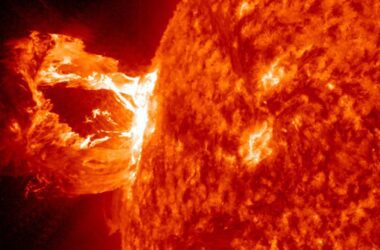Continuously launching a stream of dust from Earth’s moon could help to combat climate change
Paola Iamunno/Getty Images/iStockphoto
Reducing global warming by preventing sunlight from reaching Earth by launching a dust cloud from the moon may take more than a decade of research. Uncertainty also surrounds the potential consequences of such a strategy, which may have repercussions for agriculture, ecosystems, and water quality in many regions of the world.
In the past, scientists have considered blocking out some of the sun’s rays by inserting more than 100 million tonnes of dust between Earth and the sun. Such dust would cast a shadow on Earth by absorbing or dispersing photons, the particles of light.
This may be accomplished by relocating the dust to a distance of 1.5 million kilometres from Earth, where the combined gravitational force of the sun and Earth is zero. The items here remain in a stationary state at the L1st Lagrange point.
Several teams have considered putting dust at L1, however the solar wind (consisting of photons and charged particles) can slowly push dust away from its intended position, requiring correction.
Researchers at the University of Utah, led by Benjamin Bromley, ran hundreds of computer simulations to determine whether or not it would be more effective to constantly send a stream of lunar dust directly from the moon’s north pole towards L1 at a speed of 2.8 kilometres per second.
The models imply that each driven dust particle would spend around five days in this scenario scattering throughout the solar system and obscuring sunlight destined for Earth.
The simulations found that keeping a dust shield with a mass of 1 million tonnes near L1 for a year could dim sunlight across Earth by 1.8 per cent, equivalent to completely blocking sunlight for six days. This is after accounting for the gravitational pull of the sun, Earth, and other planets, as well as non-gravitational forces like the solar wind.
According to Ben Kravitz of Indiana University in Bloomington, this strategy has the potential to counteract the increase in carbon dioxide levels that has happened since the industrial revolution, if it is maintained indefinitely or until alternative procedures are adopted to remove carbon dioxide from Earth’s atmosphere.
If this approach is successful, it might significantly lower global temperatures, but it’s unclear if this benefit justifies the cost.
Bromley suggests using a railgun, which uses electromagnetic energy to drive objects, to shoot lunar dust into L1. This was not modelled in the simulations. This would be ideal, he believes, since it could be powered by solar panels covering only a few square kilometres of land located close to the launch location.
However, according to Kravitz, darkening the entire planet will have varying consequences in various locations. “Temperature, precipitation, winds, and many other things will change [as a result of this strategy], and they will change differently in different places,” he explains. There will be repercussions for farming, ecology, and water quality as a result of these shifts.
According to Curtis Struck of Iowa State University, extensive engineering studies should be conducted by several organisations in different nations, with the United Nations’ input.
Inaccuracies in the launch and dispersal of the dust, which might have unanticipated consequences, are another concern. Would more micrometeorite falls to Earth and harm to satellites in low Earth orbit be a result, asks Struck? There has not been enough research into this subject or many others like it.
The consideration of such a strategy, however, should not substitute our ongoing efforts to reduce global carbon emissions. According to Bromley, “we have to keep reducing the greenhouse gases within our own atmosphere.” Simply said, “our dust shield solution would buy us more time.”
Q1: How does the lunar dust cloud combat climate change?
A1: The lunar dust cloud would block sunlight from reaching Earth, reducing solar radiation and potentially mitigating global warming.
Q2: What is the proposed location for the lunar dust cloud?
A2: The dust cloud is intended to be placed at a distance of 1.5 million kilometers from Earth at the L1 Lagrange point.
Q3: How effective is the lunar dust cloud in reducing sunlight reaching Earth?
A3: Computer simulations suggest that a dust shield with a mass of 1 million tonnes near L1 could dim sunlight across Earth by 1.8%, equivalent to blocking sunlight for six days.
Q4: What technology could be used to shoot lunar dust into L1?
A4: The use of a railgun powered by solar panels is suggested as a method to launch lunar dust into L1.
Q5: What are the potential consequences of the lunar dust cloud?
A5: The strategy may have varying effects on temperature, precipitation, winds, and ecosystems, impacting farming, ecology, and water quality in different regions.







